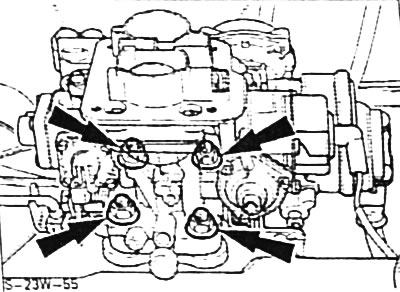Attention! When removing the carburetor, fuel may spill. Gasoline and its vapors are poisonous and flammable, so the workplace must be well ventilated. Avoid getting fuel on the skin. Wear fuel resistant gloves. No open flame, fire hazard!
Withdrawal
Disconnect ground wire (-) battery.
Caution: Disconnecting the battery will erase the contents of the electronic memories, such as engine trouble codes or radio codes. Before switching off, also read the instructions in chapter "Removing and installing the battery".
Remove the air filter see p. 57.
Disconnect the plug connector of the automatic start-up enrichment device.
Pierburg 2V carburetor: Loosen the clamps and disconnect both coolant hoses from the start-up enricher cap. If terminal clamps are installed, they must be cut and replaced with clamps tightened with a screw during assembly. Suspend the coolant hoses so that the liquid does not spill out of them.
Weber 2V-ISC carburetor: Disconnect the carburetor stepper motor plug by pushing in the locking tabs.
Detach the throttle link from the throttle valve drive shaft.
Unscrew the fastening of the holder of the thrust of the gas.
Attention: The gas draft must not have kinks, otherwise this may lead to its breakdown later in the course of operation. In any case, a broken link should be replaced.
Pierburg 2V and Weber 2V-TLD carburetors: disconnect and plug the fuel line at the carburetor, for which first release and move the clamp back. If a terminal clamp is installed, it must be cut off and, during assembly, replaced with a clamp tightened with a screw. You can plug the fuel line by inserting a clean bolt of a suitable diameter into the hose.
Mark vacuum hoses at carburetor with adhesive tape and disconnect.

Pierburg 2V carburetor: Unscrew 3 socket head bolts -arrows- and raise carburetor.

Weber 2V-ISC carburetor: Unscrew 4 securing nuts -arrows- and lift carburetor together with seal.
Weber 2V-TLD carburetor: unscrew 4 bolts with internal spokes in the head and raise the carburetor.
Installation
Clean the sealing surfaces of the carburetor and intake manifold. Make sure that no dirt gets into the intake manifold.
Remove the rag, attach the carburetor with a new seal and screw it on.
Connect the vacuum hoses to the carburetor body according to the markings.
Pierburg 2V and Weber 2V-TLD carburetors: connect the fuel line at the carburetor and secure with a clamp.
Caution: The tightening screw of the clamp must not touch the surrounding parts.
Weber 2V-TLD carburetor: connect the fuel supply and return lines at the carburetor and secure with clamps.
Caution: The tightening screws of the clamps must not touch the surrounding parts.
Screw on the throttle link holder and hang it on the throttle valve drive shaft.
Weber 5V-ISC carburetor: connect the carburetor stepper motor plug.
Connect the plug connector of the automatic start-up enrichment device.
Install the air filter see p. 57.
Connect ground wire (-) battery.
If available, set the clock and enter the radio's anti-theft code.
Check and, if necessary, adjust the engine idling speed and CO content.
Visitor comments